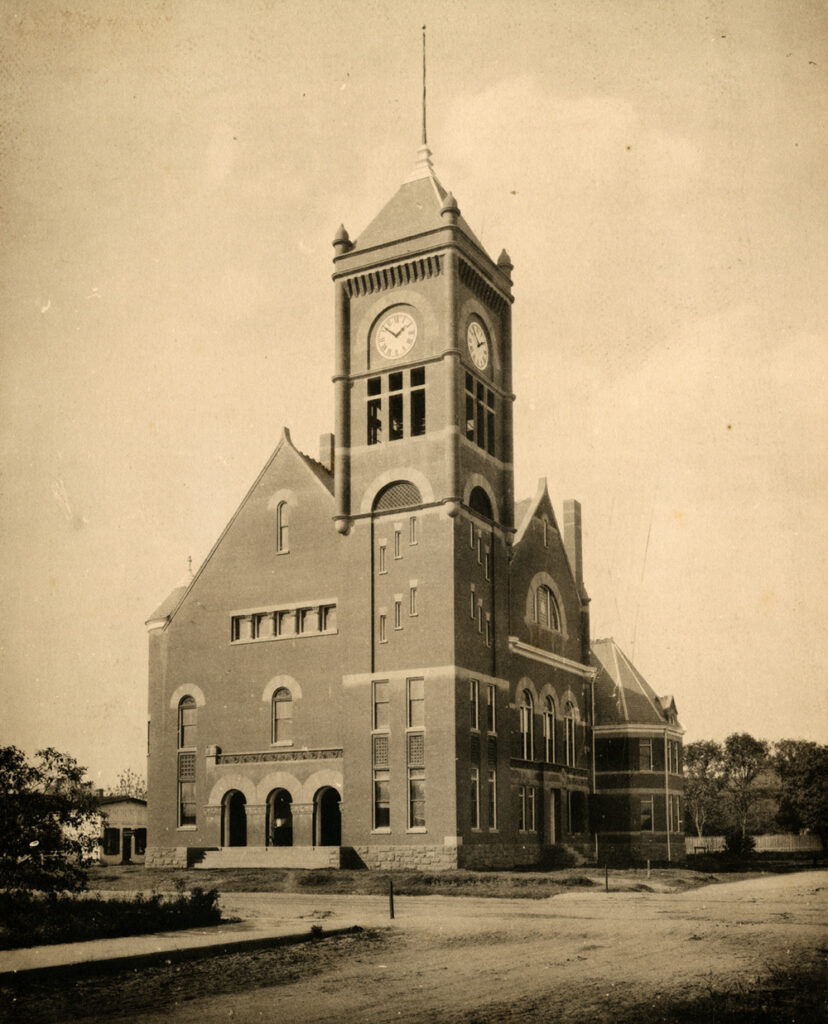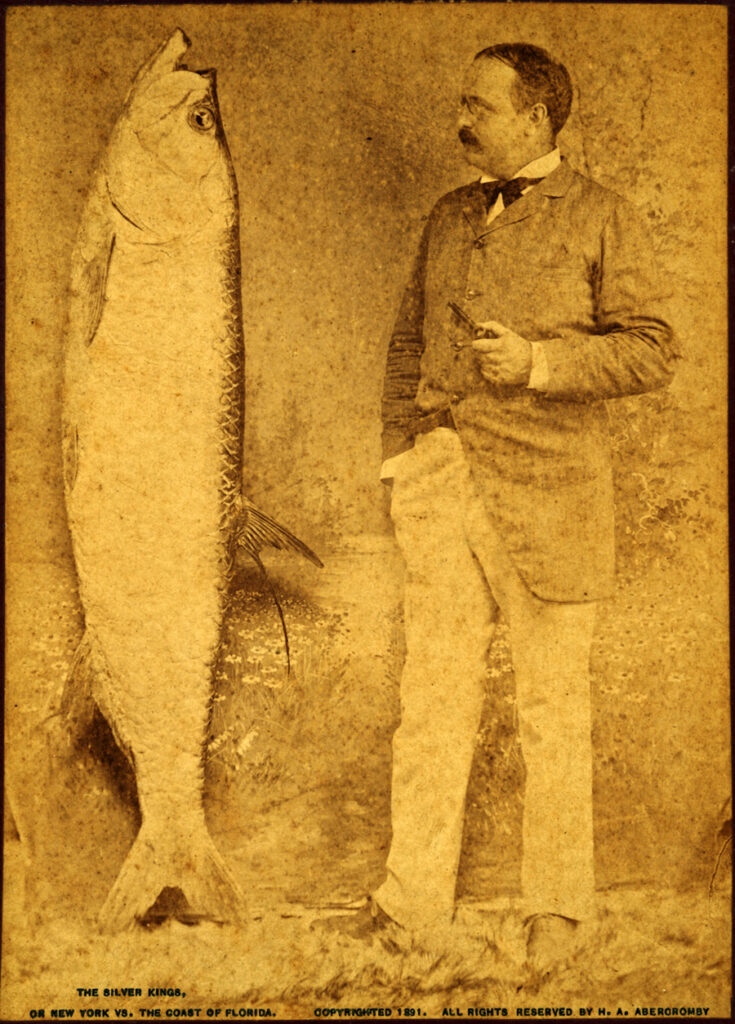A Long-Ago Photo Sparks Intrigue 200 Miles from Home
By Vanessa Sardon, from the Spring 2022 edition of Reflections Magazine
Stacks of framed art and abandoned photographs lined the shelves of a Fort Lauderdale thrift store – among them, a captivating black-and-white photo in a simple black frame. It features a group of people dressed in late-19th-century garb, standing on the steps of a building, bicycles in tow. A man leans from one of the second-story windows. A faded handwritten caption reads “South End of Courthouse,” followed by “1895,” written more legibly.

The back of the photo is stamped with the words “Orange County Historical Museum Photo / Copy by Permission Only.” This Orange County courthouse, photographed in 1895, bears no resemblance to its modern replacement, and it’s been more than 20 years since the museum named in the stamp was transformed into the History Center.
It’s a mystery how a copy of the photo came to the store 200 miles from Orlando, where the original resides in the History Center’s collection, but the image opened a path to the past.
The Courthouse
The courthouse shown in the photo, constructed in 1892, was a magnificent red-brick Romanesque building with an 80-foot-tall clock tower. Illustrations of the building show that it is much larger than it appears in the 1895 photo of the bicyclists. At that time, the courthouse was the largest, most prominent building in the city. In 1927, the county built a new courthouse. The old red-brick building housed county offices for a time but was condemned and ultimately demolished by the late 1950s. The bicyclists in the photo unknowingly preserved a piece of Orange County history.

The Club
These cyclists were members of the Orlando Bicycle Club, and the 1895 photo commemorated the group’s first official race. Bicycling boomed in Orlando in the 1890s, in part due to Leslie Pell-Clarke, an influential transplant from the North who brought his love of cycling down to Central Florida. He was known to have mapped several bicycle paths around the city’s now-historic areas. The intriguing bicycle pioneer inevitably left his mark in many ways on Central Florida.

The Clarke Family
Long before Leslie Pell-Clarke ever pedaled through Orlando, his family planted their roots firmly in colonial New York. In 1714, George Clarke, lieutenant governor of New York, married Anne Hyde, the daughter of North Carolina’s governor, Edward Hyde.
The Hyde family traces its lineage back to the English royal family. In the United States, however, the name is known for its connection to the Hyde properties and farmlands in Cooperstown, New York. In 1817, Lt. Gov. Clarke’s great-grandson, also named George Clarke, began construction on the mansion that would become Hyde Hall. His son, George Clarke Jr., inherited the Hyde Hall estate, substantial land, and family wealth.
In 1834, Anna Clarke, younger sister of George Clarke Jr., married Duncan C. Pell, the son of auction company founder William Ferris Pell. The couple lived in Newport, Rhode Island, and in 1853 welcomed their son Leslie.
George Clarke Jr. continued his father’s work experimenting with agriculture and farming. His son George Hyde Clarke moved into Hyde Hall in the 1880s and managed the estate and adjacent family farms. The property was handed down twice more, to George Hyde Clarke Jr. in 1914 and then to Thomas Hyde Clarke in 1955. In 1963, the mansion and surrounding acres of farmland passed to the state of New York. The state-owned land became Glimmerglass State Park, and the property still houses the Hyde Hall mansion, which remains open to visitors.

Leslie Pell-Clarke
In 1876, Leslie Pell-Clarke married Henrietta Temple. The New York couple enjoyed northeastern summers but preferred to winter in warmer weather, and in 1890 they purchased their Orlando home on North Main Street, just a few years before the Orlando Bicycle Club photograph was taken.
Pell-Clarke’s appreciation for cycling rivaled his love of golf. In 1893, he built a nine-hole golf course – Orlando’s first – along the northern shore of Lake Eola. While that course no longer exists, Pell-Clarke’s golf legacy lives on in Springfield, New York, where he and former classmate Henry L. Wardwell opened the Otsego Golf Club in 1894 with other founders including Pell-Clarke’s cousin George Hyde Clarke. When Pell-Clarke died in 1904, Arthur Ryerson took his place as a prime club supporter, as Pell-Clarke had no children. Ryerson died during the sinking of the RMS Titanic in 1912, but others in his family survived. In 1914, his daughter Emily married Pell-Clarke’s second cousin George Hyde Clarke Jr. (son of the golf club founder).
In 1900, the Pell-Clarkes donated their Orlando home to the local Episcopal Diocese to serve as a residence for Bishop William Gray. The property changed hands one more time when it was purchased by the county in 1925. The house was demolished, and the land became the site for the Orange County courthouse that opened in 1927, replacing the red-brick courthouse in our photo. The Orange County Regional History Center is now housed in this building, on the land once owned by Pell-Clarke himself. The History Center’s collection includes a photo of Leslie Pell-Clarke and his family during their time in Orange County, circa 1893.

Leu House Links
Although the Pell-Clarke home no longer exists, the Pell family also had ties to the historic Leu House, which overlooks Lake Rowena at Harry P. Leu Gardens. One of Leslie Pell-Clarke’s nephews, Duncan Clarkson Pell, owned the house in the early years of the 20th century and lived there with his second wife, the future silent movie star Helen Gardner.
Their marriage was somewhat scandalous, considering that Duncan Pell had only been divorced from his first wife, Anna Ogden Pell, for a week before marrying the much younger Gardner. Anna Pell was said to have dismissed her husband’s Florida-issued divorce decree. Instead, she sued him for divorce in her home state of New York.
During their time in the home, Duncan and Helen Pell made additions to the home that doubled it in size, making it ideal for the large get-togethers they hosted on weekends. Orlando businessman Harry P. Leu and his wife, Mary Jane, purchased the property in 1936, long after Pell had sold it. Leu Gardens is now owned by the City of Orlando (see LeuGardens.org).

Cycling Legacy Continues
Bicyclists today face hurdles Leslie Pell-Clarke would never know. The most notable of them: traffic. The City of Orlando has undertaken numerous transportation projects aimed at improving accessibility and safety for bicyclists. Orlando’s bicycle network currently boasts 45 miles of off-street trails that offer cyclists a traffic reprieve. Those inspired to celebrate Pell-Clarke’s cycling legacy can explore Orlando’s many bicycle trails. Detailed information and bicycle-loop maps are available on the city’s website, Orlando.gov.

